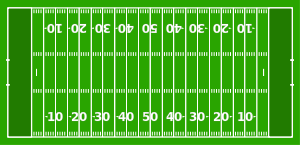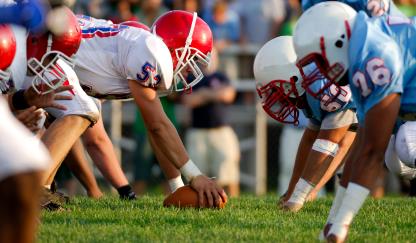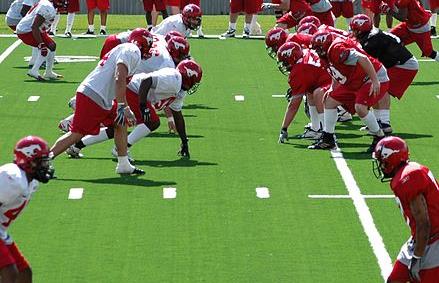 |
GRIDIRON RULES |
|---|
This relates to the CFL (Canadian Football), NFL (American Football) and the UFL (alternative American Football) but there are also variations in terms of both US and Canadian College Football which are not represented.
FIELD
The field varies between which Gridiron code is being used but with distances on a football field being stated in terms of yards.
American Football

An NFL football field is 120 yards long and 53.3 yards wide with end zones of 10 yards each and the goal posts positioned at the back of the end zone.
Canadian Football

A standard CFL football field is 150 yards long and 65 yards wide with end zones of 20 yards each and the goal posts positioned at the front of the end zone. In the case of Molson Stadium, in Montreal,PQ (home of the Montreal Alouettes), there is a surrounding running track, also the case for university stadiums, the end zones are often cut off in the corners to accommodate the track. The end zones in Toronto's BMO Field are only 18 yards instead of 20 yards.
End zones
The areas at each end of the field between the goal lines and end lines including the goal lines themselves are called the end zones. The end zones are where touchdowns, two-point conversions, and safeties are scored, and where touchbacks occur.
PLAYERS
American Football has 11 players per team and Canadian Football has 12. The Offense is the passing/running team and the defense is the attacking team.
Each possession is called a play and always starts with the Scrimmage, and both teams align up against the 'invisible' line of scrimmage made up of 7 players per team. The line is marked by the placement of the ball in American Football (image 1) and 1 yard between the teams in Canadian Football (image 2).


kickoff
At the beginning of a game, the referee tosses a coin and allows the captain of the visiting team to call heads or tails who then has the option of either to kick off or receive or which direction of the field to play in. Teams usually choose to defer so the team that wins the coin toss to kick to begin the first half and receive in the second.
Kickoff starts from the 35 yard line.
DOWNS
Both American Football (4 downs) and Canadian Football (3 downs) use a system of downs in order to gain 10 yards. The final down, if a team has not gained 10 yards, is often used to score a field goal or punt the ball away to the opposing team as far down the field as possible to negatively impact their set of downs when they take over as the offense.
SCORING
Touchdown - 6 points
This is when a player crosses their opponent's end zone, or when the ball crosses or touches the plane of the opponent's goal-line.
Conversion or Extra point - 1 point/2points
After a touchdown, the scoring team gets one scrimmage play to attempt to add one or two more points. If they make what would normally be a field goal, they score one point (a "point-after"); and what would normally be a touchdown scores two points (a "two-point conversion"). In amateur games, this scrimmage is taken at the opponents' 5-yard line.
Each attempt is taken from the 25-yard line for a conversion and the 3-yard line for the 2-point conversion.
POINT AFTER TOUCHDOWN (UFL ONLY)
After a touchdown, the scoring team will have three scrimmage play options (run or pass to score an additional touchdown) either from the 2-yard line for 1 point, 5-yard line for 2 points or from the 10-yard line for 3 points. Therefore, a team could score a maximum of 9 points when scoring a touchdown.
Field goal - 3 points
This is scored either by a drop kick or place kick (except on a kickoff) when the ball, after being kicked and without again touching the ground, goes over the cross bar and between the goal posts (or between lines extended from the top of the goal posts) of the opponent's goal, worth three points. If the ball hits the upright above the cross-bar before going through, it is not considered a dead ball, and the points are scored.
If the field goal is missed, but the ball is not returnable after crossing the dead-ball-line, then it constitutes a rouge (see below).
Single (rouge) - 1 points (CANADIAN FOOTBALL)
This is scored when the ball becomes dead in the possession of a team in its own goal area, or when the ball touches or crosses the dead-line, or side-line-in-goal, and touches the ground, a player, or some object beyond these lines as a result of the ball having been kicked from the field of play into the goal area by the scoring team. It is worth one point. This is different from a Safety (see above) in that team scored against receives possession of the ball after the score.
Safety - 2 points
Scored when the ball becomes dead in the possession of a team in its own goal area, or when the ball touches or crosses the dead-line, or side-line-in-goal and touches the ground, a player, or some object beyond these lines as a result of the team scored against making a play. The ball is then turned over to the receiving team (who gained the two points), by way of a kickoff from the 25-yard line or scrimmaging from the 35-yard line on their side of the field.